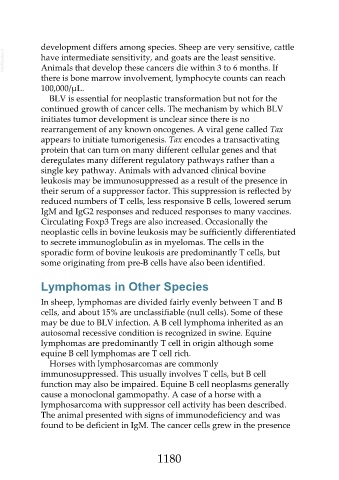Page 1180 - Veterinary Immunology, 10th Edition
P. 1180
development differs among species. Sheep are very sensitive, cattle
VetBooks.ir have intermediate sensitivity, and goats are the least sensitive.
Animals that develop these cancers die within 3 to 6 months. If
there is bone marrow involvement, lymphocyte counts can reach
100,000/µL.
BLV is essential for neoplastic transformation but not for the
continued growth of cancer cells. The mechanism by which BLV
initiates tumor development is unclear since there is no
rearrangement of any known oncogenes. A viral gene called Tax
appears to initiate tumorigenesis. Tax encodes a transactivating
protein that can turn on many different cellular genes and that
deregulates many different regulatory pathways rather than a
single key pathway. Animals with advanced clinical bovine
leukosis may be immunosuppressed as a result of the presence in
their serum of a suppressor factor. This suppression is reflected by
reduced numbers of T cells, less responsive B cells, lowered serum
IgM and IgG2 responses and reduced responses to many vaccines.
Circulating Foxp3 Tregs are also increased. Occasionally the
neoplastic cells in bovine leukosis may be sufficiently differentiated
to secrete immunoglobulin as in myelomas. The cells in the
sporadic form of bovine leukosis are predominantly T cells, but
some originating from pre-B cells have also been identified.
Lymphomas in Other Species
In sheep, lymphomas are divided fairly evenly between T and B
cells, and about 15% are unclassifiable (null cells). Some of these
may be due to BLV infection. A B cell lymphoma inherited as an
autosomal recessive condition is recognized in swine. Equine
lymphomas are predominantly T cell in origin although some
equine B cell lymphomas are T cell rich.
Horses with lymphosarcomas are commonly
immunosuppressed. This usually involves T cells, but B cell
function may also be impaired. Equine B cell neoplasms generally
cause a monoclonal gammopathy. A case of a horse with a
lymphosarcoma with suppressor cell activity has been described.
The animal presented with signs of immunodeficiency and was
found to be deficient in IgM. The cancer cells grew in the presence
1180

